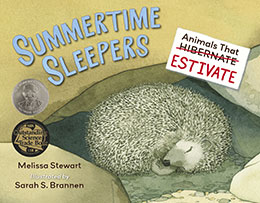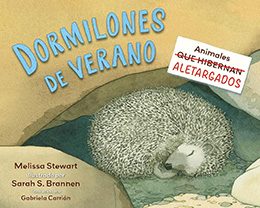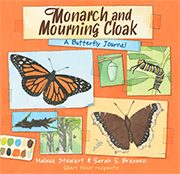Summertime Sleepers
Animals That Estivate

by Melissa Stewart
illus by Sarah S. Brannen
Charlesbridge, 2021
ISBN 978–1‑58089–716‑7
Purchase this book at your local independent bookseller or Amazon.com.

ISBN 978–162354-559–8
What do mourning cloak butterflies have in common with pixie frogs and yellow-bellied marmots? They all estivate, or sleep through summer. Everyone knows about hibernation, but this book offers young readers a lyrical look at its fascinating warm-weather counterpart. Discover how a variety of animals survive by taking a break during the hottest days of the year.
Take a look at this recorded panel presentation in which Melissa discusses Summertime Sleepers and the Joy of Nonfiction.
Honors and Awards
- Abilene ISD (TX) Mockingbird List
- ALA Notable
- Bank Street College Best Children’s Book of the Year
- Charter Oak Children’s Book Award Nominee
- Dogwood Book List for Nonfiction
- Evanston Public Library Blueberry Award Honor Title
- Fuse #8 Production Best Science & Nature Books
- Junior Library Guild Selection
- Keystone to Reading Elementary Book Award Finalist
- National Science Teaching Association Outstanding Science Trade Book
- New York Public Library Best Books for Kids
- Nerdy Book Club Award for Nonfiction Picture Books
- Oklahoma Library Association’s Donna Norvell Book Award
- Oregon State Literacy Association’s Patricia Gallagher Children’s Choice Book Award
- Robert F. Sibert Informational Book Medal, Honor
- Scripps National Spelling Bee Book Selection
Reviews
“Employing her splendid talent for making science cool, Melissa Stewart introduces young readers to creatures that go dormant not through the winter, but during the summer. … Her enthusiasm for these unfamiliar snoozers, combined with stunningly realistic watercolor illustrations by Sarah S. Brannen, make summer sleepers the superstars in this charming nonfiction picture book.” (Shelf Awareness)
“… hooks kids on the concept of estivation from page 1.” (Parents Magazine)
“Representing groups as diverse as insects, crustaceans, fish, amphibians, reptiles, and mammals, the animals include the tiny mangrove killifish that flips head-over-tail until it lands in a water-filled hollow log, and the versatile yellow-bellied marmot, which outdoes itself by hibernating and estivating … Stewart’s lively text offers entertaining factoids while clearly explaining how different animals use estivation to survive in hot, dry places. Brannen’s pleasing illustrations, both sketches and watercolor scenes, enable the audience to envision the animals within their habitats. An attractive science book on an uncommon but interesting topic.” (Booklist)
“Stewart’s prose balances a conversational tone with easily absorbed facts about estivating beings across several continents … Inset diagrams with species details plus near-photorealistic illustrations by Brannen make the subject matter more accessible for visual learners. Budding biologists will especially appreciate this intriguing primer on a lesser-known process.” (Publishers Weekly)
“A well-crafted and attractive text for animal fans, and a suitable introduction to the scientific concept of estivation.” (School Library Journal)
“[T]he child-friendly text… gives a large amount of information which is easily taken in and digested through the different elements of the text and illustrations. This well-crafted book [is] an empowering, engaging, informative treat!” (The News Gazette, Champaign, IL)
“Stewart and Brannen team up again for another fantastic read. I love the “sketchbook” drawings Brannen includes on each page. Also a very interesting author’s note, especially if you talk about text structure with your students.” (Michele Knott, elementary literacy educator)
Behind the Book
“Sometimes I like to scan the shelves in the natural history section of my town library and see what grabs my attention. On a hot June day in 2011, I stumbled upon a 250-page tome on hibernation. It contained a single paragraph about an animal behavior I’d never heard of—estivation. And that made me curious.
“To find out more, I typed “estivat” into a database of science journals, hoping to pull up papers with any form of the word—estivate, estivation, estivating. The reference sections of those initial papers led me to more resources, and soon I had plenty of material for a book.
“Because there were so many great examples from every corner of the animal kingdom, I knew early on that I’d write a list book. To make the presentation engaging and emphasize the diversity of the animals, I decided to use a compare-and-contrast structure with layered text. But I struggled with voice. At first, I tried a lively, humorous voice. But it just didn’t feel right for a book about inactive animals. I needed to let the topic dictate the voice, so a soft, cozy, lyrical voice was a better fit.
“Next, I had to admit that my beginning wasn’t working. After a year of being stuck, I realized that my introduction was buried on page eight. After cutting the first fifty words, I added to and reorganized the animal examples. Then I sent the manuscript to my editor. With her guidance, I tightened the structure, strengthened the flow and pacing, and reworked the back matter. Finally, the text was ready for publication.”


ISBN 978–162354-559–8
Purchase this book at your local independent bookseller or Amazon.com.
Book Extensions
REVISION DECISIONS
INTERACTIVE TEACHING TOOL
VIDEO: ROCKIN’ RESEARCH




